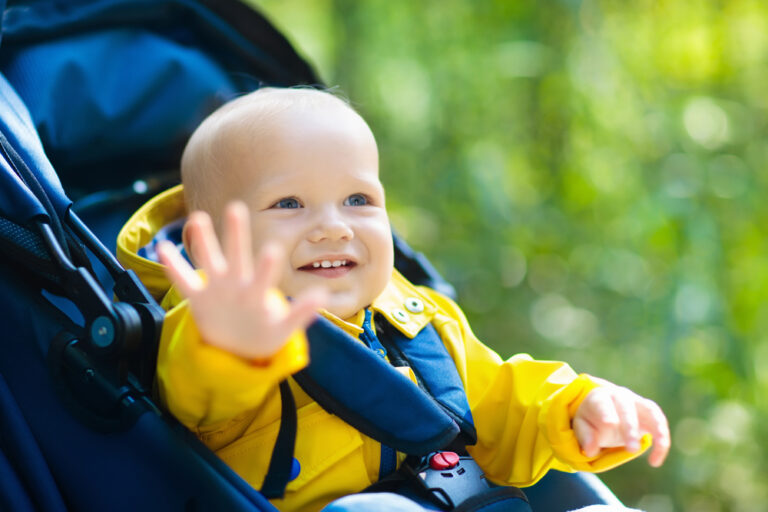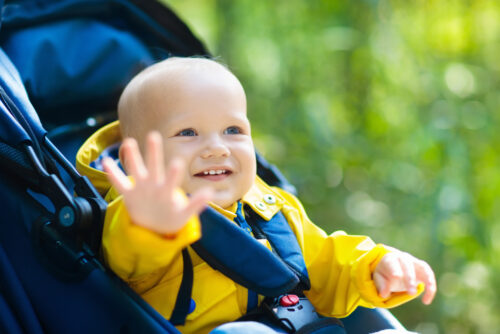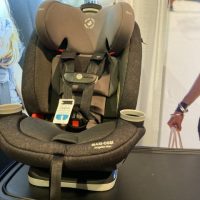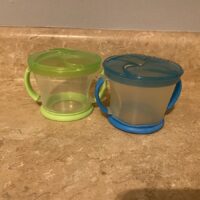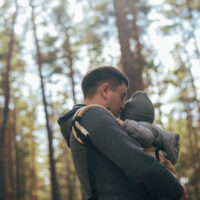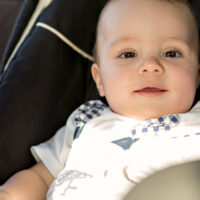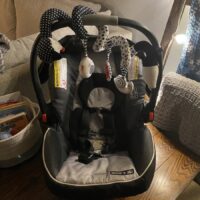A stroller is a new parent registry must-have and likely one of the most expensive. The great news is you can get your money’s worth and good use out of a stroller from day one. That is only if you know what kind of stroller to buy and what features to look out for.
In this article, we will break down what you need to know about stroller safety from the experts, plus when your baby can sit in a stroller.
How to Use a Stroller with a Newborn
Newborns must be fully reclined when riding in strollers because they cannot sit up or hold their heads up without support. When the child is 5 to 7 months and can hold their head up, sitting upright, they may be ready to use a stroller sitting up according to Maxi Cosi.
Newborns can ride safely in a stroller in two ways: with a travel system or a bassinet attachment.
Using Travel Systems with Infants
A travel system refers to an infant car seat that clicks into a compatible stroller. This allows parents to transport their sleeping newborns from their car seat into a stroller without unbuckling and waking them and vice versa. Infant car seats often come with vehicle bases that allow you to easily click in and secure baby back into the car.
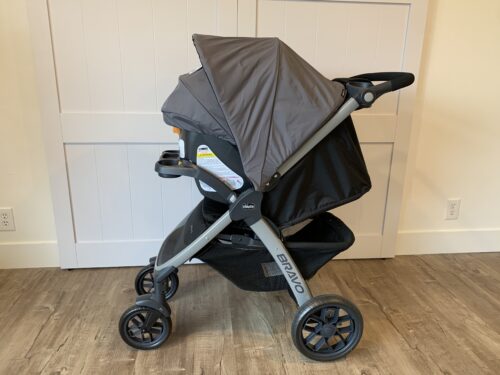
Travel systems often come in infant car seat and stroller sets, but you can mix and match brands, as long as they are compatible and offer the proper attachments you can buy separately.
One important thing to note: although it is safe for newborns to sleep in their car seats when they are out for a stroll or when in a vehicle, doctors at the American Academy of Pediatrics do not recommend using car seats for sleep when not traveling because it can pose a risk to newborns and infants. In fact, experts suggest not letting babies sleep or relax in the car seat for more than two hours. Your little one should always be in your view when they are sleeping in the car seat.
We have rounded up the best travel systems, providing in-depth reviews of both the infant car seat and stroller, in this article. Give it a read before you decide which travel system is best for you and your baby!
Using Infant Bassinet Strollers
Some stroller models offer an infant bassinet attachment that allows newborns to lay flat. It works similarly to how you would click in and attach an infant car seat into a stroller, but it is a portable bassinet instead.
Compatible infant bassinet attachments do not come with every stroller and can be pricey. They are good options, however, if you do not drive often and don’t need a travel system. For example, if you live in a big city where you walk everywhere, you may get great use out of an infant bassinet because you can easily take your newborn for a stroll.
You likely will not use the bassinet attachment on your stroller for very long. Once babies can roll, it is time to switch out of the bassinet and into a seat with a safety buckle, such as an infant car seat or regular stroller. The UPPABaby Vista Strolleris among the most popular bassinet strollers because you can switch to the regular seat once babies outgrow the bassinet.
Reminder: though many strollers on the market offer multiple recline positions, even the deepest recline on a regular stroller seat is not flat enough for a newborn. The 5-point harness buckle is likely too large to safely secure a newborn as well.
When To Transition Baby into Regular Stroller Seat
Your baby can ride in a stroller without the car seat or infant bassinet attachments once they can sit up unassisted.
This happens at different times for babies. According to the Centers for Disease Control and Prevention, some babies can start sitting with some support by 4 months to 6 months. By 6 months of age, some babies may not need assistance sitting up and holding their own heads up.
Here are some things to consider when choosing a stroller that will grow with your baby:
- Multiple Recline Positions: Even though your baby can hold his or her head up, it may still be comfortable for them to ride in a stroller at an incline. Find a stroller that has multiple recline positions, so you can find which angle is most supportive and comfy for your baby. Finding a stroller that lays far back is also great when your little one becomes a toddler, so he or she can nap on the go!
- 5-Point Harness Buckle: Most strollers come with a 5-pointy safety harness that will keep your little one secure when riding in a stroller. Your child, no matter how old, should always be buckled when sitting in a stroller. Strollers come with multiple harness positions to grow with your baby. Use the harness position that is above and closest to your child’s shoulder line for the safest, most comfortable fit.
- Reversible Seat: This feature is often overlooked and does not come with every stroller. A reversible seat means the regular stroller seat can be facing you pushing the stroller or facing out. Once your little one hits toddlerhood, he or she is going to want to face out and see what’s going on in the world around them. But a reversible seat is handy when your infant is still young but big enough to ride in a regular seat. It not only allows you to keep a close eye on your baby, but you can make eye contact and talk to him or her as you’re on a stroll.
Final Word About Finding the Best Stroller For You and Baby
When choosing a stroller, find one that will grow with your baby from newborn to toddlerhood. Also, examine your lifestyle to determine the best fit. (Do you drive a lot? Do you want to take your baby out when jogging?)
No matter which stroller you choose, try to opt for one that provides an adequate sunshade with a UPF/SPF canopy. This is especially important to protect little ones younger than 6 months old who cannot wear sunscreen. And another biggie: good storage space. Because let’s face it! Babies require a lot of stuff when you leave the house!
Happy strolling!
